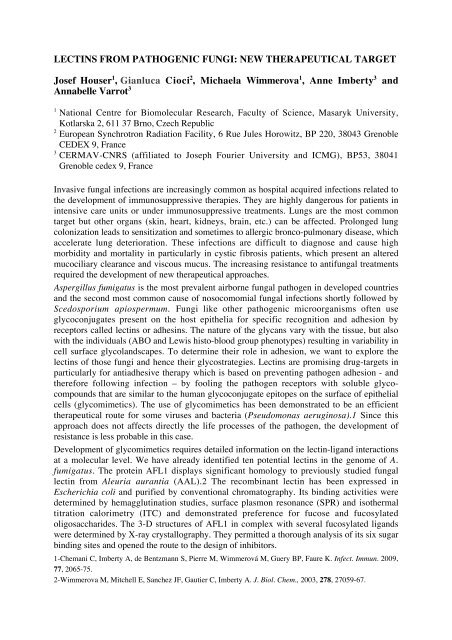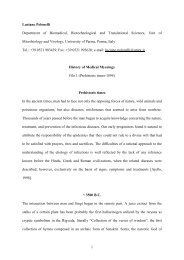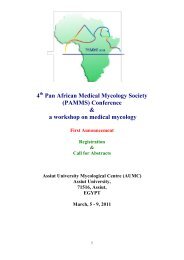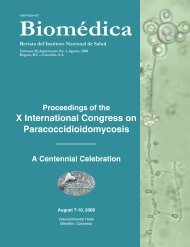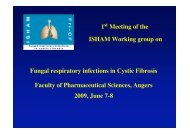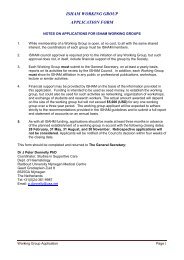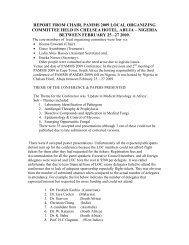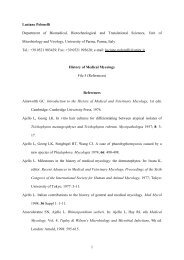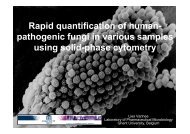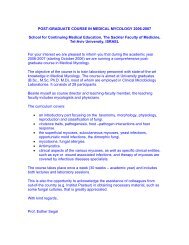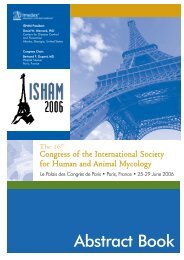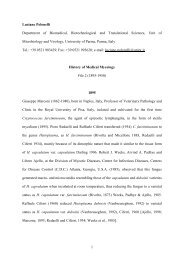Abstract book 2011 - ISHAM
Abstract book 2011 - ISHAM
Abstract book 2011 - ISHAM
Create successful ePaper yourself
Turn your PDF publications into a flip-book with our unique Google optimized e-Paper software.
LECTINS FROM PATHOGENIC FUNGI: NEW THERAPEUTICAL TARGETJosef Houser 1 , Gianluca Cioci 2 , Michaela Wimmerova 1 , Anne Imberty 3 andAnnabelle Varrot 31 National Centre for Biomolecular Research, Faculty of Science, Masaryk University,Kotlarska 2, 611 37 Brno, Czech Republic2 European Synchrotron Radiation Facility, 6 Rue Jules Horowitz, BP 220, 38043 GrenobleCEDEX 9, France3 CERMAV-CNRS (affiliated to Joseph Fourier University and ICMG), BP53, 38041Grenoble cedex 9, FranceInvasive fungal infections are increasingly common as hospital acquired infections related tothe development of immunosuppressive therapies. They are highly dangerous for patients inintensive care units or under immunosuppressive treatments. Lungs are the most commontarget but other organs (skin, heart, kidneys, brain, etc.) can be affected. Prolonged lungcolonization leads to sensitization and sometimes to allergic bronco-pulmonary disease, whichaccelerate lung deterioration. These infections are difficult to diagnose and cause highmorbidity and mortality in particularly in cystic fibrosis patients, which present an alteredmucociliary clearance and viscous mucus. The increasing resistance to antifungal treatmentsrequired the development of new therapeutical approaches.Aspergillus fumigatus is the most prevalent airborne fungal pathogen in developed countriesand the second most common cause of nosocomomial fungal infections shortly followed byScedosporium apiospermum. Fungi like other pathogenic microorganisms often useglycoconjugates present on the host epithelia for specific recognition and adhesion byreceptors called lectins or adhesins. The nature of the glycans vary with the tissue, but alsowith the individuals (ABO and Lewis histo-blood group phenotypes) resulting in variability incell surface glycolandscapes. To determine their role in adhesion, we want to explore thelectins of those fungi and hence their glycostrategies. Lectins are promising drug-targets inparticularly for antiadhesive therapy which is based on preventing pathogen adhesion - andtherefore following infection – by fooling the pathogen receptors with soluble glycocompoundsthat are similar to the human glycoconjugate epitopes on the surface of epithelialcells (glycomimetics). The use of glycomimetics has been demonstrated to be an efficienttherapeutical route for some viruses and bacteria (Pseudomonas aeruginosa).1 Since thisapproach does not affects directly the life processes of the pathogen, the development ofresistance is less probable in this case.Development of glycomimetics requires detailed information on the lectin-ligand interactionsat a molecular level. We have already identified ten potential lectins in the genome of A.fumigatus. The protein AFL1 displays significant homology to previously studied fungallectin from Aleuria aurantia (AAL).2 The recombinant lectin has been expressed inEscherichia coli and purified by conventional chromatography. Its binding activities weredetermined by hemagglutination studies, surface plasmon resonance (SPR) and isothermaltitration calorimetry (ITC) and demonstrated preference for fucose and fucosylatedoligosaccharides. The 3-D structures of AFL1 in complex with several fucosylated ligandswere determined by X-ray crystallography. They permitted a thorough analysis of its six sugarbinding sites and opened the route to the design of inhibitors.1-Chemani C, Imberty A, de Bentzmann S, Pierre M, Wimmerová M, Guery BP, Faure K. Infect. Immun. 2009,77, 2065-75.2-Wimmerova M, Mitchell E, Sanchez JF, Gautier C, Imberty A. J. Biol. Chem., 2003, 278, 27059-67.


